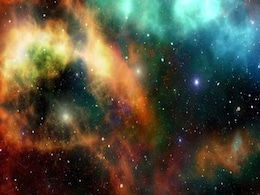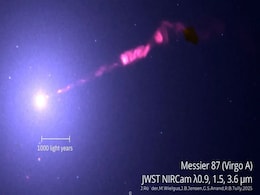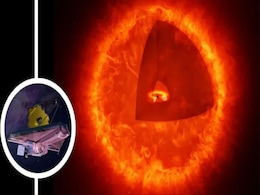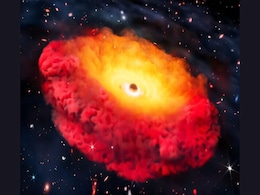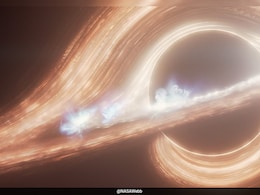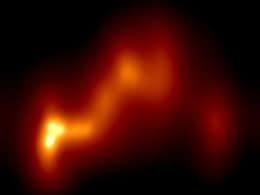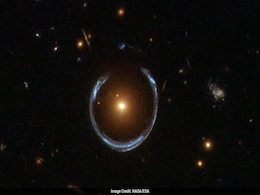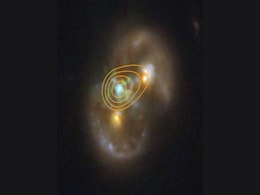Supermassive Black Holes
- All
- News
-

Indian Team Finds 53 Massive Quasars Blasting Jets Millions of Light-Years Long
- Tuesday December 2, 2025
- Written by Gadgets 360 Staff
Astronomers in India have identified 53 previously unknown giant radio quasars powered by supermassive black holes, each releasing enormous plasma jets reaching up to 7.2 million light-years—nearly 50 times the Milky Way’s diameter. Using GMRT data, the team expanded the catalog of known giant quasars and offered valuable clues about how black ...
-
 www.gadgets360.com
www.gadgets360.com
-

James Webb Telescope May Have Discovered Universe’s Earliest Supermassive Black Hole
- Tuesday November 25, 2025
- Written by Gadgets 360 Staff
James Webb may have discovered the universe’s earliest supermassive black hole in galaxy GHZ2. Observations reveal high-energy emission lines, challenging existing models of rapid black hole and galaxy growth. Upcoming JWST and ALMA studies aim to confirm AGN activity and refine our understanding of early cosmic evolution.
-
 www.gadgets360.com
www.gadgets360.com
-

ESA’s Euclid Telescope Charts Over a Million Galaxies in Landmark First Data
- Wednesday November 19, 2025
- Written by Gadgets 360 Staff
ESA’s Euclid space telescope has captured about 1.2 million galaxies in its first year, providing one of the most detailed wide-field surveys of the universe ever made. Covering distances up to 10 billion light-years, Euclid’s clear, expansive imaging is helping astronomers study galaxy shapes, mergers, dwarf galaxy populations, and the role of...
-
 www.gadgets360.com
www.gadgets360.com
-

Astronomers Report The Biggest Black Hole Flare Ever Seen, With Light Of 10 Trillion Suns
- Tuesday November 4, 2025
- Science | Edited by Ritu Singh
The observed black hole flare is believed to be the largest and most distant one ever recorded, coming from 10 billion light-years away.
-
 www.ndtv.com
www.ndtv.com
-

Star-Eating Black Hole Unleashes Record-Setting Energetic Flare
- Tuesday November 4, 2025
- World News | Reuters
Scientists are observing the most energetic flare ever seen emanating from a supermassive black hole, apparently caused when this celestial beast shredded and swallowed a huge star that strayed too close.
-
 www.ndtv.com
www.ndtv.com
-

Pulsar Observations Could Reveal Gravitational Wave Interference From Black Holes
- Wednesday October 15, 2025
- Written by Gadgets 360 Staff
A new study proposes detecting gravitational-wave “beats” using pulsar timing. Researchers from Hirosaki University suggest that interference between waves from supermassive black hole binaries could appear as periodic variations in pulsar signals. The method may help distinguish individual sources from a diffuse gravitational-wave background i...
-
 www.gadgets360.com
www.gadgets360.com
-

Astronomers Capture First Image of Two Supermassive Black Holes Orbiting Each Other
- Tuesday October 14, 2025
- Written by Gadgets 360 Staff
Astronomers have captured the first image of two supermassive black holes orbiting in quasar OJ 287. The smaller black hole’s jet spirals due to gravitational forces from the larger one. This discovery validates dual-core theories and opens doors for research on gravitational waves and galaxy evolution.
-
 www.gadgets360.com
www.gadgets360.com
-

JWST Reveals Stunning New Details About M87’s Supermassive Black Hole Jet
- Saturday October 4, 2025
- Written by Gadgets 360 Staff
Recent images captured by the James Webb Space Telescope (JWST) are the clearest ever pictures of the jet arriving from the massive black hole in the galaxy named Messier 87 (M87). There are clear details in the image shot by the telescope, which show the change of brightness, shape and the jet that is usually in disguise. As per scientists, this d...
-
 www.gadgets360.com
www.gadgets360.com
-

NASA’s Chandra Finds Black Hole Growing Beyond Known Limits
- Sunday September 28, 2025
- Written by Gadgets 360 Staff
A black hole in quasar RACS J0320-35, 12.8 billion light-years away, is growing 2.4 times faster than theory permits. Chandra’s discovery challenges ideas of how supermassive black holes formed so soon after the Big Bang.
-
 www.gadgets360.com
www.gadgets360.com
-

Tiny Red Dots Spotted By NASA’s James Webb Telescope Could Be Black Hole Stars
- Thursday September 25, 2025
- Written by Gadgets 360 Staff
NASA’s James Webb Space Telescope revealed mysterious “little red dots” that seem too bright and mature for their age. A new study suggests they may be black hole stars—giant hydrogen spheres powered by black holes—helping explain the rapid growth of early supermassive black holes.
-
 www.gadgets360.com
www.gadgets360.com
-

Astronomers Discover Rogue Black Hole Racing Through a Distant Dwarf Galaxy
- Sunday September 14, 2025
- Written by Gadgets 360 Staff
Astronomers have discovered a rogue intermediate-mass black hole speeding through a dwarf galaxy 230 million light-years away. Unlike typical galactic centres, this displaced object is accreting material and blasting out jets, suggesting black holes can grow “offsite”. The finding offers rare evidence of elusive intermediate black holes and may...
-
 www.gadgets360.com
www.gadgets360.com
-

Scientists Predict 90% Chance Of Black Hole Explosion By 2035 That Could Reveal Universe's Secrets
- Saturday September 13, 2025
- Science | Edited by Abhinav Singh
The predicted explosion could be strong evidence of a theorised but never observed kind of black hole, called a "primordial black hole".
-
 www.ndtv.com
www.ndtv.com
-

Twisted Jet Confirms Most Extreme Binary Black Hole System in the Universe
- Sunday August 10, 2025
- Written by Gadgets 360 Staff
Astronomers have confirmed that the blazar OJ 287 hosts the most extreme binary black hole system ever found. Using a global radio telescope array, they captured an ultra-sharp image showing a dramatically bent jet—evidence of two supermassive black holes locked in orbit. The system’s 12-year flare cycle and jet twists match predictions of a sm...
-
 www.gadgets360.com
www.gadgets360.com
-

Biggest-Ever Black Hole With Mass Of 36 Billion Suns Discovered: 'Cosmic Behemoth'
- Saturday August 9, 2025
- Offbeat | Edited by Abhinav Singh
The gigantic black hole's size is close to the theoretical upper limit of what is possible in the universe.
-
 www.ndtv.com
www.ndtv.com
-

JWST Finds Black Hole Between Galaxy Cores, Hinting at Rare Direct Collapse Birth
- Thursday July 17, 2025
- Written by Gadgets 360 Staff
Using JWST, astronomers discovered a black hole between two galaxy cores in the Infinity Galaxy—possibly the first direct evidence of a black hole formed by gas collapse, not stellar death. This rare “heavy seed” black hole challenges standard models and could help explain how supermassive black holes appeared so soon after the Big Bang.
-
 www.gadgets360.com
www.gadgets360.com
-

Indian Team Finds 53 Massive Quasars Blasting Jets Millions of Light-Years Long
- Tuesday December 2, 2025
- Written by Gadgets 360 Staff
Astronomers in India have identified 53 previously unknown giant radio quasars powered by supermassive black holes, each releasing enormous plasma jets reaching up to 7.2 million light-years—nearly 50 times the Milky Way’s diameter. Using GMRT data, the team expanded the catalog of known giant quasars and offered valuable clues about how black ...
-
 www.gadgets360.com
www.gadgets360.com
-

James Webb Telescope May Have Discovered Universe’s Earliest Supermassive Black Hole
- Tuesday November 25, 2025
- Written by Gadgets 360 Staff
James Webb may have discovered the universe’s earliest supermassive black hole in galaxy GHZ2. Observations reveal high-energy emission lines, challenging existing models of rapid black hole and galaxy growth. Upcoming JWST and ALMA studies aim to confirm AGN activity and refine our understanding of early cosmic evolution.
-
 www.gadgets360.com
www.gadgets360.com
-

ESA’s Euclid Telescope Charts Over a Million Galaxies in Landmark First Data
- Wednesday November 19, 2025
- Written by Gadgets 360 Staff
ESA’s Euclid space telescope has captured about 1.2 million galaxies in its first year, providing one of the most detailed wide-field surveys of the universe ever made. Covering distances up to 10 billion light-years, Euclid’s clear, expansive imaging is helping astronomers study galaxy shapes, mergers, dwarf galaxy populations, and the role of...
-
 www.gadgets360.com
www.gadgets360.com
-

Astronomers Report The Biggest Black Hole Flare Ever Seen, With Light Of 10 Trillion Suns
- Tuesday November 4, 2025
- Science | Edited by Ritu Singh
The observed black hole flare is believed to be the largest and most distant one ever recorded, coming from 10 billion light-years away.
-
 www.ndtv.com
www.ndtv.com
-

Star-Eating Black Hole Unleashes Record-Setting Energetic Flare
- Tuesday November 4, 2025
- World News | Reuters
Scientists are observing the most energetic flare ever seen emanating from a supermassive black hole, apparently caused when this celestial beast shredded and swallowed a huge star that strayed too close.
-
 www.ndtv.com
www.ndtv.com
-

Pulsar Observations Could Reveal Gravitational Wave Interference From Black Holes
- Wednesday October 15, 2025
- Written by Gadgets 360 Staff
A new study proposes detecting gravitational-wave “beats” using pulsar timing. Researchers from Hirosaki University suggest that interference between waves from supermassive black hole binaries could appear as periodic variations in pulsar signals. The method may help distinguish individual sources from a diffuse gravitational-wave background i...
-
 www.gadgets360.com
www.gadgets360.com
-

Astronomers Capture First Image of Two Supermassive Black Holes Orbiting Each Other
- Tuesday October 14, 2025
- Written by Gadgets 360 Staff
Astronomers have captured the first image of two supermassive black holes orbiting in quasar OJ 287. The smaller black hole’s jet spirals due to gravitational forces from the larger one. This discovery validates dual-core theories and opens doors for research on gravitational waves and galaxy evolution.
-
 www.gadgets360.com
www.gadgets360.com
-

JWST Reveals Stunning New Details About M87’s Supermassive Black Hole Jet
- Saturday October 4, 2025
- Written by Gadgets 360 Staff
Recent images captured by the James Webb Space Telescope (JWST) are the clearest ever pictures of the jet arriving from the massive black hole in the galaxy named Messier 87 (M87). There are clear details in the image shot by the telescope, which show the change of brightness, shape and the jet that is usually in disguise. As per scientists, this d...
-
 www.gadgets360.com
www.gadgets360.com
-

NASA’s Chandra Finds Black Hole Growing Beyond Known Limits
- Sunday September 28, 2025
- Written by Gadgets 360 Staff
A black hole in quasar RACS J0320-35, 12.8 billion light-years away, is growing 2.4 times faster than theory permits. Chandra’s discovery challenges ideas of how supermassive black holes formed so soon after the Big Bang.
-
 www.gadgets360.com
www.gadgets360.com
-

Tiny Red Dots Spotted By NASA’s James Webb Telescope Could Be Black Hole Stars
- Thursday September 25, 2025
- Written by Gadgets 360 Staff
NASA’s James Webb Space Telescope revealed mysterious “little red dots” that seem too bright and mature for their age. A new study suggests they may be black hole stars—giant hydrogen spheres powered by black holes—helping explain the rapid growth of early supermassive black holes.
-
 www.gadgets360.com
www.gadgets360.com
-

Astronomers Discover Rogue Black Hole Racing Through a Distant Dwarf Galaxy
- Sunday September 14, 2025
- Written by Gadgets 360 Staff
Astronomers have discovered a rogue intermediate-mass black hole speeding through a dwarf galaxy 230 million light-years away. Unlike typical galactic centres, this displaced object is accreting material and blasting out jets, suggesting black holes can grow “offsite”. The finding offers rare evidence of elusive intermediate black holes and may...
-
 www.gadgets360.com
www.gadgets360.com
-

Scientists Predict 90% Chance Of Black Hole Explosion By 2035 That Could Reveal Universe's Secrets
- Saturday September 13, 2025
- Science | Edited by Abhinav Singh
The predicted explosion could be strong evidence of a theorised but never observed kind of black hole, called a "primordial black hole".
-
 www.ndtv.com
www.ndtv.com
-

Twisted Jet Confirms Most Extreme Binary Black Hole System in the Universe
- Sunday August 10, 2025
- Written by Gadgets 360 Staff
Astronomers have confirmed that the blazar OJ 287 hosts the most extreme binary black hole system ever found. Using a global radio telescope array, they captured an ultra-sharp image showing a dramatically bent jet—evidence of two supermassive black holes locked in orbit. The system’s 12-year flare cycle and jet twists match predictions of a sm...
-
 www.gadgets360.com
www.gadgets360.com
-

Biggest-Ever Black Hole With Mass Of 36 Billion Suns Discovered: 'Cosmic Behemoth'
- Saturday August 9, 2025
- Offbeat | Edited by Abhinav Singh
The gigantic black hole's size is close to the theoretical upper limit of what is possible in the universe.
-
 www.ndtv.com
www.ndtv.com
-

JWST Finds Black Hole Between Galaxy Cores, Hinting at Rare Direct Collapse Birth
- Thursday July 17, 2025
- Written by Gadgets 360 Staff
Using JWST, astronomers discovered a black hole between two galaxy cores in the Infinity Galaxy—possibly the first direct evidence of a black hole formed by gas collapse, not stellar death. This rare “heavy seed” black hole challenges standard models and could help explain how supermassive black holes appeared so soon after the Big Bang.
-
 www.gadgets360.com
www.gadgets360.com






